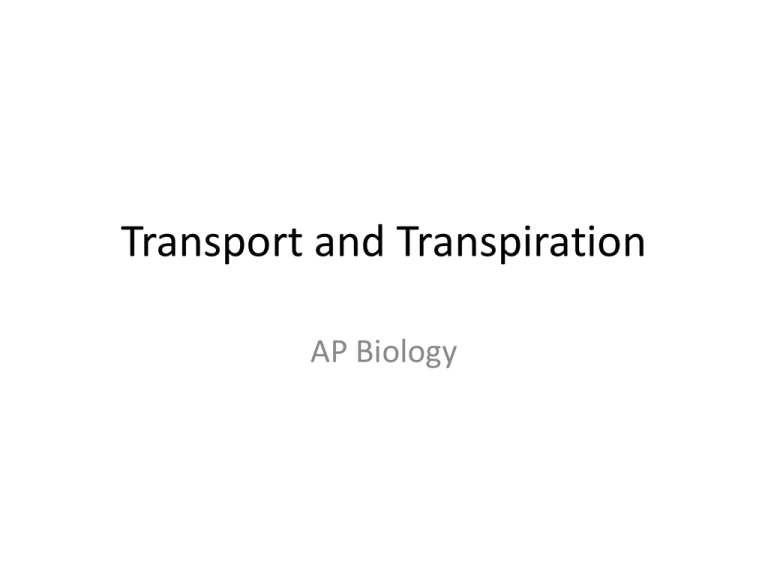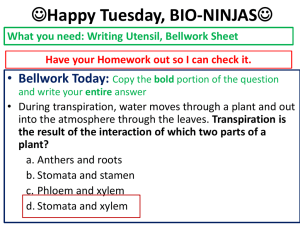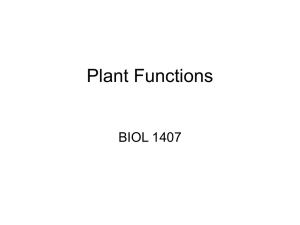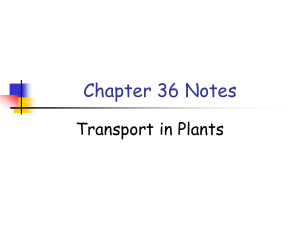
Transport and Transpiration
AP Biology
Transport of Water
• Water and minerals enter root through root hairs
osmosis: Two pathways toward center of root exist.
1. Apoplast pathway. (nonliving path): Water moves
through cell walls never entering cells:
2. Symplast pathway (living path): Water moves from
cell to cell via plasmodesmata
• Water crosses endodermis to vascular cylinder (stele)
of root via symplast pathway. Apoplast blocked by
Casparian strip.
Three Mechanisms for Water Movement
1. Osmosis: Concentration gradient must exist: Two
ways – Xylem removing H2O from root, and active
concentration of minerals.
At night, positive root pressure may develop forcing
xylem sap upward. Guttation is the leaving of water
droplets due to upward root pressure and reduced
transpiration.
2. Capillary action due to adhesion – Minimal effect.
3. Cohesion-Tension Mechanism
Transpiration – Evaporation of water from the leaves
causes a negative pressure or tension in the leaves.
Cohesion: Hydrogen bonding of water molecules
produces a single, polymer-like column of water in
xylem, extending from roots to leaves.
Bulk Flow: Occurs as water molecules evaporate from
leaves. As a molecule of water evaporates by
transpiration, the entire water column is pulled upward.
Functions in long distance transport
Also termed transpiration pull.
Bulk flow is mainly due to a low p in the leaves.
Cohesion and Adhesion of water molecules- A review
The transpirational pull created by the negative pressure in
the leaf is transmitted all the way down to the root because of
a unique property of water.
•The atoms in a water molecule are covalent, but they share
the electrons unequally, making the molecule have a polarity,
difference in charge.
•The H ends are slightly +, the O end is slightly negative.
•Water molecules are attracted to each other, forming weak
bonds (H+ bonds) between the molecules.
•So there is one long unbroken chain between the molecules
in the column of water in the xylem.
•Water molecules also adhere to the walls of the xylem due
to H bonds.
Cohesion - Tension
• Water is pulled up the xylem by the water lost in
transpiration
• The sun provides the energy to ‘pull’ the water up by
providing the energy for evaporation
• Water moves up the xylem by mass flow from the higher
pressure in roots to the lower pressure in the leaves
• The column of water does not break because of the
cohesive forces between the water molecules
-
+
+
-
+
+
• A variety of physical processes
– Are involved in the different types of transport
4 Through stomata, leaves
take in CO2 and expel O2.
The CO2 provides carbon for
photosynthesis. Some O2
produced by photosynthesis
is used in cellular respiration.
CO2
O2
5 Sugars are produced by
photosynthesis in the leaves.
Light
H2 O
Sugar
3
Transpiration, the loss of water
from leaves (mostly through
stomata), creates a force within
leaves that pulls xylem sap upward.
6 Sugars are transported as
phloem sap to roots and other
parts of the plant.
Water and minerals are
transported upward from
roots to shoots as xylem sap.
2
1 Roots absorb water
and dissolved minerals
from the soil.
Figure 36.2
O2
H2 O
Minerals
CO2
7 Roots exchange gases
with the air spaces of soil,
taking in O2 and discharging
CO2. In cellular respiration,
O2 supports the breakdown
of sugars.
Which cells transport nutrients?
Xylem cells transport water and minerals
up the stem from the roots to the shoots
and leaves. This transport occurs in one
direction only.
Phloem cells transport sugars produced
in the leaves up
and down the stem to growing and
storage tissues.
The cells are arranged in plants as vascular bundles.
How is xylem adapted for transportation?
Water and minerals travel in xylem vessels.
Xylem vessels have thick cellulose cell walls,
strengthened by lignin. The inside of the cell
is hollow. Xylem vessels are dead cells.
Capillary action, root pressure, cohesiontension
Water is pulled upward by negative
pressure in the xylem
Capillary
Water rises up narrow tubes due to the adhesive
forces between the water molecules and the wall
of the tube
Water rises higher in
narrower tubes
Xylem vessels are very
narrow
Limitations
1.Water will only rise 50mm
2.The flow rate is slower than the rate
observed in xylem
Root Pressure
Root pressure causes the
mercury to rise in the
manometer
Water
Cut stump of a
well watered plant
Mercury
Manometer
Root Pressure
• Water is pushed up the xylem by hydrostatic pressure
• Mineral salts are pumped into the xylem vessels in the root by the
endodermal cells
• Lowering the in the xylem
• Water moves in from the surrounding cells by osmosis
• Raising the hydrostatic pressure so pushing water up the xylem
Water movement across the leaf
cuticle
upper epidermis
palisade mesophyll
xylem
water is pulled along the
xylem
water moves into cells down
gradient by osmosis
spongy mesophyll
lower epidermis
cuticle
stoma
water evaporates from the
spongy mesophyll cell
surface lowering cell
The Cohesion Tension Hypothesis for Movement of Water up the
Xylem Vessels
Lower pressure/tension
at top of xylem
Transpiration
Water evaporates from the
spongy mesophyll cells and
diffuses into the atmosphere
Lower in the leaf cells
Water is pulled
up xylem vessels
Water moves from down the gradient
Water moves across root
from soil down gradient
Cohesive forces between water
molecules prevent water column
breaking
Via the apoplast and
symplast paths
Xylem
sap
Outside air
= –100.0 MPa
Mesophyll
cells
Stoma
Water
molecule
Leaf (air spaces)
= –7.0 MPa
Transpiration
Atmosphere
Leaf (cell walls)
= –1.0 MPa
Water potential gradient
Trunk xylem
= – 0.8 MPa
Xylem
cells
Cohesion
and adhesion
in the xylem
Adhesion
Cell
wall
Cohesion,
by
hydrogen
bonding
Water
molecule
Root xylem
= – 0.6 MPa
Root
hair
Soil
= – 0.3 MPa
Soil
particle
Figure 36.13
Water uptake
from soil
Water
Nutrient Transport
Many plants pump sugars into their fruits
In cold climates, plants pump food into
their roots
The stored food must be moved when growth
occurs in spring
How is phloem adapted to transportation?
Phloem is made of columns of living cells. They
transport food, in the form of sugars (sucrose).
Sugars are carried from the leaves to the
growing and storage parts of the plants.
This movement takes place in both
directions.
Source Sink
Source- cell where sugars are produced
Sink- cell where food is stored
Phloem cells are also called sieve tubes. Cells are
joined by small holes in the cell wall at the end
of each cell, forming a continuous system. The
end cell walls are called sieve plates.
Transport of Sugars
•Sugar is produced by the leaves and
actively transported to the sieve tube
members.
•Water enters sieve tube members and
creates a positive pressure.
•Pressure moves sugar solution from
source to sink.
•Sugars are removed from the sieve
tubes at the sink maintaining the
gradient.
•Facilitated by cohesion and adhesion
Phloem loading and unloading
•Sugar needs to be loaded into the phloem before it can be
translocated
•Sugar can move from mesophyll cells to sieve tube members
by the symplast pathway (cell to cell through plasmodesmata)
•Another route is a combination of symplast and apoplast
pathways
•Companion cells pass sugar they have accumulated into the
sieve tube members through plasmodesmata
•Sugar is also moved by active transport by cotransport with H+
ions
•At the sink end sugar moves down its concentration gradient
into the sink by diffusion and water follows by osmosis
Phloem loading
• In many plants
– Phloem loading requires active transport
• Proton pumping and cotransport of sucrose and
H+
– Enable the cells to accumulate sucrose
High H+ concentration
H+
Proton
pump
Figure 36.17b
(b) A chemiosmotic mechanism is responsible for
the active transport of sucrose into companion cells
and sieve-tube members. Proton pumps generate
an H+ gradient, which drives sucrose accumulation
with the help of a cotransport protein that couples
sucrose transport to the diffusion of H+ back into the cell.
Cotransporter
S
Key
ATP
Low
H+
H+
concentration
H+
Sucrose
S
Apoplast
Symplast
What is transpiration?
Transpiration is the loss of water by evaporation from plants.
Plants lose water when they open the stomata in the leaves to let
in carbon dioxide.
Water always moves from an area of high concentration to
an area of low concentration. This movement of water is a
type of diffusion called osmosis.
Air around the plant usually contains less water than
the cells of the plant, so water evaporates into the air.
In xylem negative pressure, or tension, drives long distance transport. Transpiration;
the evaporation of water from the leaf, reduces pressure in the xylem.
Water Pressure
•The movement of
water out of the leaf
“pulls” water upward
through the vascular
system all the way from
the roots.
–Transpirational pull.
Copyright Pearson Prentice Hall
Is the rate of transpiration constant?
Transpiration is a bit like a straw, pulling water up the plant.
Sometimes the pulling force will be stronger and the plant will lose
more water.
The speed at which a plant loses water is called the rate of
transpiration. This varies depending on the plant’s
environment.
What environmental factors will affect the rate of
transpiration?
humidity (amount of moisture in the air)
light intensity
temperature
air movement (wind).
What are stomata?
On the underside of leaves are small holes, or pores, called stomata.
Each stoma is surrounded by two guard cells, which control the opening and closing of
the stoma.
When carbon dioxide levels are low inside the plant, the guard
cells gain water and become turgid. They curve out, opening
the stoma and allowing gases in and out. Water also evaporates
through stomata.
High carbon dioxide levels cause the guard cells to lose water,
closing the stoma.
What would happen if the stomata were permanently
open?
Regulating Stomatal Opening:-the
potassium ion pump hypothesis
Guard cells flaccid
K+
K+ ions have the same concentration in
guard cells and epidermal cells
K+
K+
K+
K+
K+
K+
K+
K+
K+
K+
Stoma closed
27
K+
Light activates K+ pumps which
actively transport K+ from the
epidermal cells into the guard cells
H2O
H2O
K+
H2O
K+
K+
K+
H2O
28
K+
K+
Increased concentration of K+ in
guard cells
K+
K+
Lowers the in the guard cells
K+
K+
K+
H2O
K+
Water moves in by osmosis, down
gradient
Guard cells turgid
H2O
K+
K+
HO
2
K+
K+
H2O
K+
K+
Stoma open
29
Increased concentration of K+ in
guard cells
H2O
K+
Lowers the in the guard cells
K+
H2O
K+
K+
H2O
K+
K+
Water moves in by osmosis, down
gradient
Questions
1.
Explain, in terms of water potential how water moves from the
soil to the endodermis in a root
2. Explain why, in summer, the diameter of a branch is smaller at
noon than at midnight.
3. Explain the root pressure hypothesis for water movement in
the xylem.
4. Give two limitations of this hypothesis.
Answer Q1
• Water is absorbed from the soil by the root hairs
• By osmosis down the water potential gradient
• The water potential is higher in the epidermal cells than in the
xylem in the root centre
• Water moves from cell to cell through the cytoplasm down the
water potential gradient
• Water also moves through the fibres of the cell wall and
intercellular spaces
• But must go through the endodermal cells due to the Casparian
strip
Answer Q2
•
•
•
•
•
•
Temperature higher at noon so transpiration rate higher
More water evaporates from the surface of the mesophyll cells
Reducing the the water potential
Water moves from the xylem in the leaves into the cells
Creating a tension pulling the water up the xylem
This pulls the xylem vessels in so reducing the diameter of the
trunk
Answer Q3
• Root pressure is a hydrostatic pressure pushing water up the
xylem
• Mineral ions are actively transported out of the endodermal
cells into the xylem vessels
• Lowering the water potential in the xylem
• So water moves in from the surrounding cells by osmosis /
down the water potential gradient
• Raising the hydrostatic pressure
Answer Q4
• The pressure measured is not enough to get water to the top of
trees
• Only find root pressure in spring
• Relies on the use of the plant’s energy (ATP) for active transport







